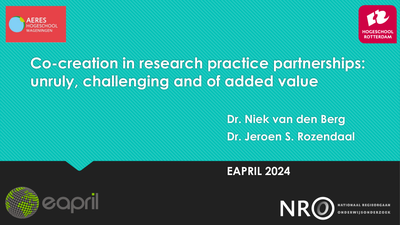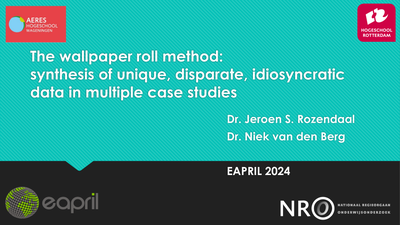Rapport van het gemeenschappelijke project van de lectoraten 'Kunst en samenleving' en 'Stedelijke strategieën' over het ontwikkelen van een culturele strategie voor de stad Hasselt. Enerzijds is een sociologisch model ontwikkeld voor een gebalanceerde artistieke biotoop. Anderzijds hebben studenten architectuur en stedenbouw concrete interventies in de stad voorgesteld om aan deze artistieke biotopen vorm en inhoud te geven.
DOCUMENT
Workshop EAPRIL Conference, November 26 - 28, Hasselt
DOCUMENT

Paper-presentation EAPRIL Conference, November 26 - 28, Hasselt.
DOCUMENT

Onderzoek naar de praktijk van re-integratie van alleenstaande moeders naar de arbeidsmarkt in Maastricht, Hasselt en Aken. Wat zien professionals (en beleidsmakers) als probleem en oplossing en hoe ziet de doelgroep dat zelf? Hoe kunnen die verschillen overbrugd worden? Een vergelijking over de grenzen kan een extra dimensie geven aan een onderzoek, maar ook aan de verbetering van de praktijk. Het rapport dat voor u ligt: “Bijstandsmoeders in Maastricht” is het resultaat van het eerste deelonderzoek. Het rapport begint met een korte beschouwing over de stand van zaken over het onderwerp, op basis van een literatuurstudie en een eerste werkveldverkenning. Na die eerste verkenning volgen twee hoofdstukken over de opzet van het onderzoek. Eerst een hoofdstuk over de opzet van het totale onderzoek, dan een hoofdstuk over de opzet en uitvoering van het deelonderzoek. Dan de ‘ziel’ van dit onderzoek: Een uitwerking van de interviews met de doelgroep ‘bijstandsmoeders in Maastricht’. De hoofdstukken volgen de thema’s die in de interviews aan de orde kwamen. Het rapport eindigt met een nabeschouwing waarin de onderzoeker reflecteert op de twaalf gesprekken, als onderzoeker, maar wellicht nog meer als docent, maatschappelijk werker en ervaringsdeskundige van heel lang geleden. Daar de geïnterviewde moeders de uitvoeringspraktijk goed kennen, heeft de onderzoeker op basis van de interviews een aantal aanbevelingen geselecteerd waar de professionals wellicht hun voordeel kunnen doen.
DOCUMENT

Eutropolis is an everchanging utopian vision for the Euregion Meuse-Rhine, an international region. A vision about to make borders fade.
DOCUMENT

A comparative study of the effects of the pandemic across six countries, including The UK, Australia, Belgium, Cyprus, Ireland and The Netherlands. The authors outline 21 design principles for mobile learning, which is hoped will help us respond effectively in the uncertain present, and plan systematically for an unpredictable, post-pandemic future. This paper is based on the emergency changes we have had to make in the European DEIMP Project (2017-2020), “Designing and Evaluating Innovative Mobile Pedagogies” (DEIMP). DEIMP is undertaken by a transnational consortium comprising partner institutions and schools from the participating countries.
MULTIFILE

Cities are constantly in transition. Spatial production worldwide is generated by governments, business, developers, informal settlers, et cetera; sometimes cities expand, but increasingly there is a process of reurbanisation of existing urban patterns contronted with deterioration, dysfunctionality, or obsolescence. In many situations, funding, power and technology determine how the course of urbanisation. Communities, groups and individuals with limited access to funding, power and technology need empowerment to exercise their right to shape and improve their own evironment, while respecting health, equity and ecology. The research centre for Smart Urban Redesign (SURD) at Zuyd University of Applied Sciences seeks to work on this empowerment for communities. This study presents SURD’s approach to neighbourhood revitalisation.
DOCUMENT

Whilst until the late 1980s most migration issues developed in a parallel manner but with national specifics, important differences showed up during the 1990s and at the beginning of this decade. Since the middle of the 1990s, there has been an obvious change in policy towards migrants and foreigners in the Netherlands, and those changes have been more or less “exported” to our neighbouring countries and even to the level of the EU. Integration into society with the maintenance of the immigrant’s own culture has been replaced by integration into the Dutch society after passing an integration examination. The focus of this article is to investigate those changes and to compare the implementation of those policies in the Netherlands/Limburg and Germany/NRW, where the official understanding of not being an immigration country was dominant until the end of the 1990s, and where integration has only recently become an important political issue. Both countries are now facing similar challenges for better integration into the society, especially into the educational system. Firstly, the autors describe migration definitions, types, the numbers of migrants and the backgrounds of migrant policies in Germany and the Netherlands up until the middle of the 1990s. Secondly they discuss the integration policies thereafter: the pathway to a new policy and the Action Plan Integration in Germany, and the central ideas of the Civic Integration of Newcomers Act (WIN) in the Netherlands. Integration policy in the Netherlands is highly centralised with little differentiation on the local governmental level when compared to South Limburg. Thirdly, the autors investigate the cross-border cooperation between professional organisations and educational institutions in the Euregio Meuse-Rhine, and the involvement of social work institutions and social workers in their process of integration into the local society and the exchange of each others’ experiences (the ECSW and RECES projects).
DOCUMENT

Optimal postural control is an essential capacity in daily life and can be highly variable. The purpose of this study was to investigate if young people have the ability to choose the optimal postural control strategy according to the postural condition and to investigate if non-specific low back pain (NSLBP) influences the variability in proprioceptive postural control strategies. Young individuals with NSLBP (n = 106) and healthy controls (n = 50) were tested on a force plate in different postural conditions (i.e., sitting, stable support standing and unstable support standing). The role of proprioception in postural control was directly examined by means of muscle vibration on triceps surae and lumbar multifidus muscles. Root mean square and mean displacements of the center of pressure were recorded during the different trials. To appraise the proprioceptive postural control strategy, the relative proprioceptive weighting (RPW, ratio of ankle muscles proprioceptive inputs vs. back muscles proprioceptive inputs) was calculated. Postural robustness was significantly less in individuals with NSLBP during the more complex postural conditions (p < 0.05). Significantly higher RPW values were observed in the NSLBP group in all postural conditions (p < 0.05), suggesting less ability to rely on back muscle proprioceptive inputs for postural control. Therefore, healthy controls seem to have the ability to choose a more optimal postural control strategy according to the postural condition. In contrast, young people with NSLBP showed a reduced capacity to switch to a more multi-segmental postural control strategy during complex postural conditions, which leads to decreased postural robustness.
LINK